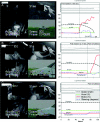Driving under low-contrast visibility conditions in Parkinson disease
- PMID: 19805726
- PMCID: PMC2764395
- DOI: 10.1212/WNL.0b013e3181bacf6e
Driving under low-contrast visibility conditions in Parkinson disease
Erratum in
- Neurology. 2010 Feb 16;74(7):616
Abstract
Objective: To assess driving performance in Parkinson disease (PD) under low-contrast visibility conditions.
Methods: Licensed, active drivers with mild to moderate PD (n = 67, aged 66.2 +/- 9.0 years, median Hoehn-Yahr stage = 2) and controls (n = 51, aged 64.0 +/- 7.2 years) drove in a driving simulator under high- (clear sky) and low-contrast visibility (fog) conditions, leading up to an intersection where an incurring vehicle posed a crash risk in fog.
Results: Drivers with PD had higher SD of lateral position (SDLP) and lane violation counts (LVC) than controls during fog (p < 0.001). Transition from high- to low-contrast visibility condition increased SDLP and LVC more in PD than in controls (p < 0.01). A larger proportion of drivers with PD crashed at the intersection in fog (76.1% vs 37.3%, p < 0.0001). The time to first reaction in response to incursion was longer in drivers with PD compared with controls (median 2.5 vs 2.0 seconds, p < 0.0001). Within the PD group, the strongest predictors of poor driving outcomes under low-contrast visibility conditions were worse scores on measures of visual processing speed and attention, motion perception, contrast sensitivity, visuospatial construction, motor speed, and activities of daily living score.
Conclusions: During driving simulation under low-contrast visibility conditions, drivers with Parkinson disease (PD) had poorer vehicle control and were at higher risk for crashes, which were primarily predicted by decreased visual perception and cognition; motor dysfunction also contributed. Our results suggest that drivers with PD may be at risk for unsafe driving in low-contrast visibility conditions such as during fog or twilight.
Figures


References
-
- Uc EY, Rizzo M, Anderson SW, et al. Visual dysfunction in Parkinson disease without dementia. Neurology 2005;65:1907–1913. - PubMed
-
- Pieri V, Diederich NJ, Raman R, et al. Decreased color discrimination and contrast sensitivity in Parkinson’s disease. J Neurol Sci 2000;172:7–11. - PubMed
-
- Hutton JT, Morris JL, Elias JW. Levodopa improves spatial contrast sensitivity in Parkinson’s disease. Arch Neurol 1993;50:721–724. - PubMed
-
- Jones RD, Donaldson IM, Timmings PL. Impairment of high-contrast visual acuity in Parkinson’s disease. Mov Disord 1992;7:232–238. - PubMed
-
- Price MJ, Feldman RG, Adelberg D, et al. Abnormalities in color vision and contrast sensitivity in Parkinson’s disease. Neurology 1992;42:887–890. - PubMed
Publication types
MeSH terms
Grants and funding
LinkOut - more resources
Full Text Sources
Medical
